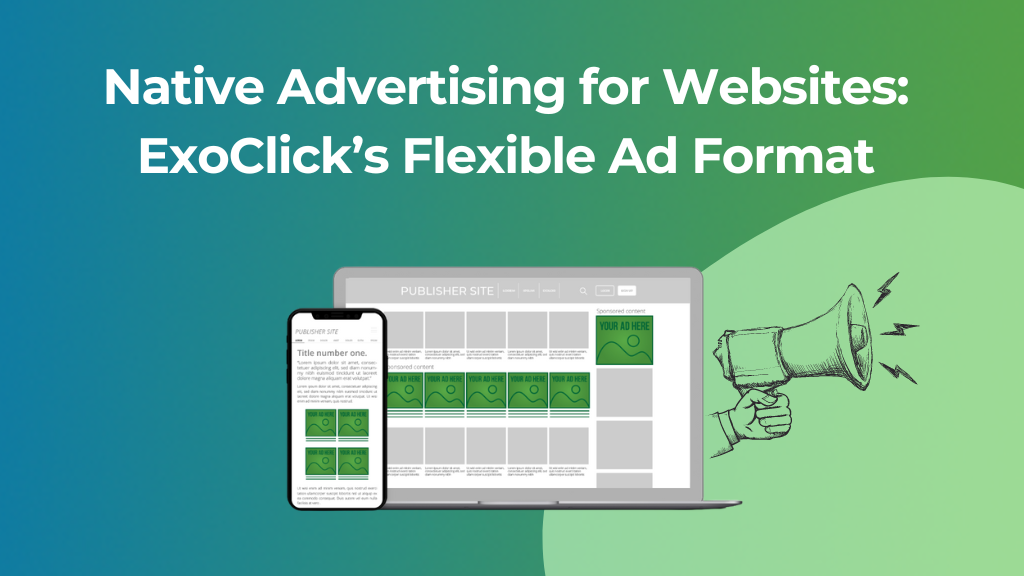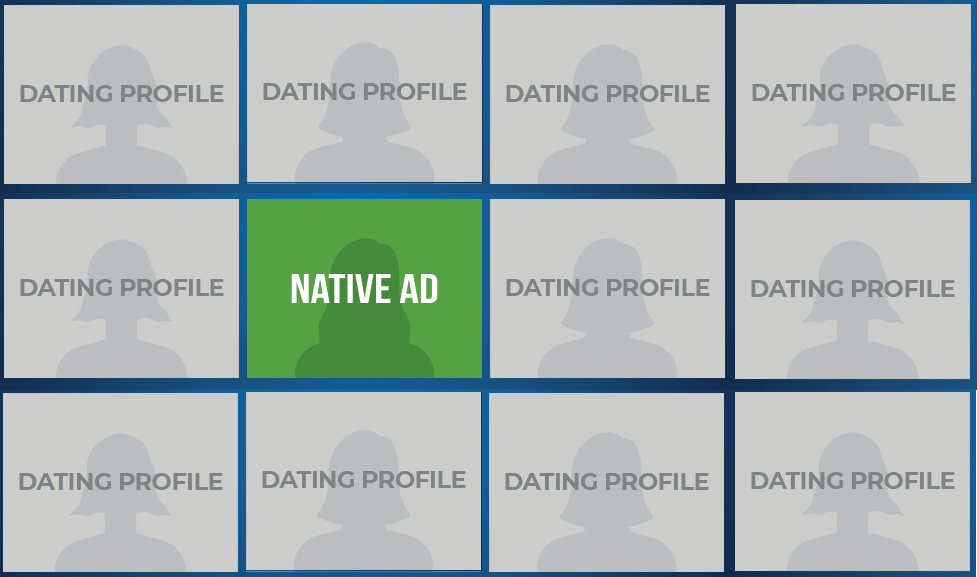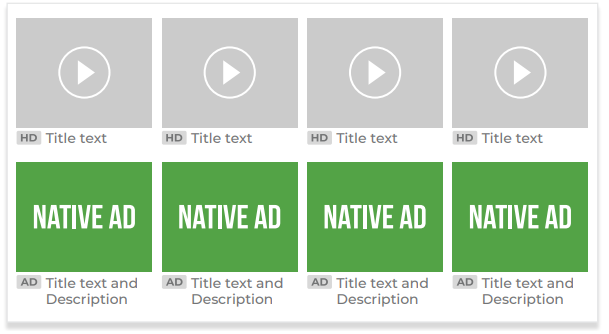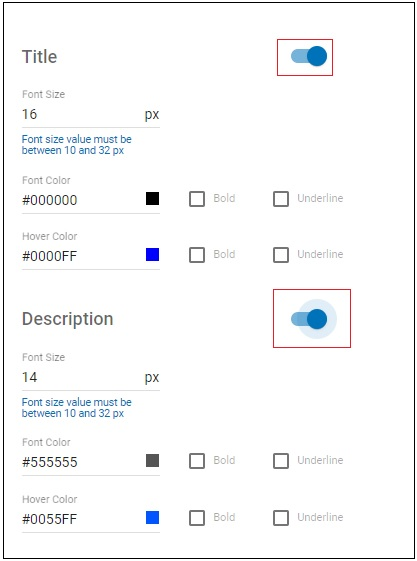Native Advertising for Websites: ExoClick’s Flexible Ad Format

Native display advertising is one of the most flexible ad formats that Publishers can use to monetize their website’s content. Advertisers love Native because it is a really creative format for them to convert their offers which creates big demand from advertisers for Native ad zones. In this article we explain everything you need to know about Native advertising for websites, how to optimize Native ad zones using ExoClick’s platform and the benefits of Native advertising for your end users and your revenues.
What is Native advertising?
A Native ad contains an Image, a Title (max 50 characters) a Description (max 90 characters) and also a Brand name (max 30 characters). As a Publisher you can create the Native ad zones to fit in with the look and feel of your content. For example, if you have a video content website that features video thumbnails for your end users to browse, your Native ad zones can be displayed to look exactly like your video content thumbnails. This is just one of the benefits of Native advertising and provides your end users with a really great user experience, but more on this later…
The Native advertising widget
To display Native advertising for websites, the Native ad zones are set up using different sizes of widget. This is another one of the benefits of Native advertising. Let’s look at the basic 1×1 widget. This 1×1 format is popular with ExoClick’s Members Area Dating sites, where the occasional Native ad appears amongst the Dating profile images, we call this an In Profile Native ad zone.

But a 1×1 can also be used for any type of site, for example a website with Gaming review videos can feature the occasional 1×1 Native ad within the video thumbnails. When using Native advertising for websites, Native advertising widgets come in a range of sizes based on rows and columns. Here is a 1×4 widget example as a Footer, see how it fits in with the content on the website:

This format is also popular for website Headers and 2×2 Native widgets are popular for NTVs or Under Video. Choosing the right sized widgets for your website is one of the ways of how to optimize Native ad zones.
Another one of the benefits of Native advertising is that Native ads are fully responsive and display seamlessly on desktop, mobile and tablet devices. All ExoClick’s Native formats are fully aligned with Google regulations as well as being carefully designed to follow the Better Ads Standards.
Native display advertising: Desktop versus Mobile
How to optimize Native ad zones when creating your Native ad zones needs a different strategy for the desktop and mobile versions of your site, because of the available screen size. Here are some recommendations when displaying Native advertising for websites:
Desktop:
1×1 use in between content thumbnails – 1 or 2 per webpage
1×3 or 1×4 use as headers and/or footers
2×2 use for NTVs and Under Video
Mobile:
1×1 use in between content thumbnails – 1 or 2 per webpage
1×1 use as Under Video
3×1 or 4×1 use as Footers
Native and Multi-Format ads
Multi-Format ads allow Publishers to create ad placements that serve multiple formats: Banners or Native in just one placement, pitching different Banner sizes and Native ad widgets against each other and serving the highest paying ad in the Multi-Format ad zone. This ability to serve multiple formats can increase the number of eligible bids for your impressions while giving advertisers access to previously unavailable inventory, opening up a whole new world of possibilities for publishers and advertisers alike.
As a Publisher you can select different Banner sizes and Native ad zones by generating a single ad script. You can choose multiple existing ad zones and let them compete against each other, showing only the one with the highest CPM value. This allows you to convert several different ad zones into Multi-Format ad zones in your admin panel by using combinations of horizontal or vertical options, so you can display different Banner sizes and Native widgets in their existing ad placements.
Looking at one of the ad placements: Desktop Footer, this is a typical large 900×250 display Banner zone. An advertiser can’t target this zone with a smaller Banner or a Native ad, however if you use the footer as a Multi-Format ad zone, this opens up new inventory for an advertiser that wasn’t previously available. With Multi-Format Ads, the Footer now has different combinations of inventory depending on which won the highest bid for either the whole Footer zone, or parts of the Footer zone.
For example a Multi Format ad Desktop Footer can display the following different combinations:
1 Banner 900×250
1 x Banner 728×90
3 x 300×250 Banners or 4 x 300×250 Banners 100% width
1 x 3 Native widget, 1 x 4 Native widget or 1 x 5 Native widget depending on the website layout.
You can track the performance of your Multi-Format Ad Zones, as well as the individual Banner and Native zones that are used within them with our Multi-Format Ad Statistics. Data can be viewed in both the Statistics tab and the Dashboard:
- In the Statistics tab data is displayed for Multi-Format Ad Zones in two reports in the Sites & Zones tab: Ad Zones and Multi-Format Zone Details
- In the Dashboard tab, there is now a Multi-Format Zone Details dimension available.
Note: In order to see these changes, you will need to have set up at least one Multi-Format ad zone in your Admin Panel, so that you can display Native advertising for websites along with Banners. Check out our article Multi-Format ads Guide for Publishers for details of how to set up Multi-Format ad zones and tips for ad placements on Desktop and Mobile.
Using Multi-Format ads can lead to a significant increase in your revenues, read our Publisher Case Study to see how one publisher increased revenues by 215.63% and a 48.67% increase in eCPM & 93.81% eCPC.
How to make Native advertising look like website content
Yet another benefit of Native advertising is that ExoClick’s admin panel allows many great editing tools to fine tune how Native advertising for websites will display. Creating a native ad zone is simple and yet powerfully customizable. You are able to use slightly different processes for setting up a Native Ad zone depending on your needs:
1 – You simply want to set up a responsive ad zone, and choose the aspect ratio of the native ad zone’s images.
2 – You want to set up the ad zone to match a custom image size or ratio, so that the ad zone looks the same as your site and fits in perfectly.
3 – You have a zone on your site of a specific size and want to create an ad zone that fits in it and looks good.
We have created an article that explains each of the above three scenarios with step by step instructions to get you started for both Desktop and Mobile versions of your website.
Using CSS to edit your Native ad zones
In addition to your admin panel tools to edit Native ad zones you can also edit using easy custom CSS code to improve the impact of how your Native ad zones are displayed. For example you can:
Place the text box over the image with a background opacity

Make the corners of the images rounded

Customize the background color of the text box

Check out our article 10 Native ad zone custom CSS ideas for Publishers for more ideas to help match your site’s content with code snippets to instantly change the look and feel of your Native ad zones.
How to optimize Native ad zones
We want you to acheive the best possible results so here are our optimization tips for Native advertising for websites:
Use Native to prevent Banner blindness: Native ads help to avoid Banner over saturation, so test Native ads against your Banner spots, you may find you will earn much higher revenues replacing them with our Native ad widget. Or use Native in conjunction with Banners by mixing formats in different positions eg. banners on NTVs, Native in content. Or use Multi-Format ad zones to let advertiser winning bids allow the display of Native or Banners.
Always enable Title and Descriptions to show in your Native ad zones: Some Publishers prefer not to enable them, but enabling Tile and Description texts in your admin panel helps advertisers achieve a higher CTR for the Native ad zone. ExoClick’s Business Intelligence department carried out an analysis of CTRs when a Native ad zone only contained an image, the average CTR without a title and/or description was 0.14%. The CTR increased to 0.23% with a title and description, that’s an overall increase of 60.8% in value to an advertiser. This in turn makes your Native ad zones more desirable for advertisers bringing the ad zone greater advertiser demand, pushing up the Native ad zone’s eCPM value.

Fallback: You can use the Native ad zone as a fallback for a Banner ad zone. If you’re going to do this, please make sure you create a different Native zone for each different Banner position, instead of using the same fallback zone on all the positions. For example, if you want a Native fallback for your NTV Banners, create a Native fallback for each different position, one for NTVA, another one for NTVB, etc. This will improve the CPMs and revenues you obtain from each fallback.
Fallback HTML: Switching on this option in your admin panel opens a few more options for your zone:
- Floor CPM: Here you can set a minimum price (floor) that the ad zone will accept for traffic.
- Type: A Soft Floor means that we will also run CPC and CPA campaigns that could have an average eCPM higher than your floor CPM, meaning that the floor is not 100% guaranteed. A Hard Floor means we will only run CPM and Smart CPM campaigns on this zone, meaning that the floor is 100% guaranteed.
Publisher case studies: To explain the best ways to optimize Native advertising for websites, we carried out 3 Publisher Case Studies for Native ads. Each Publisher was advised by their ExoClick account manager on how to experiment with Native ad zone placements. The main objectives for case studies were:
- Increase the numbers of clicks and overall CTR from Native spots. Because a large percentage of Native demand is on CPC, more clicks and a high CTR brings a higher CPM and additional revenue.
- Adding Native titles and the Powered by ExoClick label, improves the quality of the clicks for advertisers and reduces accidental clicks for users as they are aware the Native ad zone is an ad, leading to better user experience.
We looked at:
- How to optimize Native ad zones
- How the Native widget was optimized
- CTR change before and after optimisation
- CPM change before and after optimisation
- Revenue increase before and after optimisation
All Publishers saw an increase in Native ad zone performance and revenues. Check out the full Case Study: How 3 publishers increased Native ad zone CPMs.
Conclusion: The Benefits of Native Advertising
Provides a great end user experience: Because Native can be customized to appear like the editorial content of your site, it provides a great user experience. As an end user scrolls through your site’s content they do not see various different sizes of banners, they see a seamless browsing experience, with ads that look like content. Because of the advertiser flow for Native ads, we recommend to advertisers that the ad’s Landing Page should be in the style of an editorial article, and not a hard sell, this can be interesting for your visitors as the ad zone is bringing additional content they want to read or see.
Qualified clicks for advertisers: Because you have the option in your admin panel to also allow an advertiser’s Brand name text for the Native ad, the end user knows that they are clicking on an ad. This brings qualified clicks for advertisers, which means higher CTRs, making the Native ad zones more competitive and pushing up the eCPM value. This is one of the key benefits of Native advertising bringing value to the Native zone.
Totally customizable: As you have read previously, ExoClick provides a large range of tools to customize and how to optimize Native ads zones to display exactly how you would like them to display on your site.
Muli-Format ad zones: Another great benefit of Native advertising is by letting Native and Banner advertisers compete for your Multi-Format ad zones, this increases the value of the ad placement by creating competition for the same ad zone, again pushing up eCPMs.
Huge advertiser demand: Native is very popular with advertisers. It is a great way for them to give an editorial twist to their ad creative, for example if the advertiser is pushing a Dating offer, their Native ads creative text could be: “Get 5 conversation tips for a first date.” This brings value to the end user who is then taken to a Landing Page that gives them real tips for Dating. It also brings value to the advertiser because they can test different text triggers to get traffic. Advertisers also like to run test campaigns with Native to gather campaign data before launching full campaigns with other ad formats. Many advertisers like to use a mix of Native, Banners and Video to push the same offer, the different formats allow them to give different types of visuals and messaging to increase conversions for their campaign.
Dynamic keyword insertion for more personalized marketing: Advertisers can use dynamically changing texts within their Native ad campaigns. This is a highly useful feature so that the end user feels like the Native ad is talking to them. So for example, using the dynamic token for {device} in the text: “Find out why this is the most popular game on {device}”, if the end user is viewing the Native ad on an iPhone 13 the text displayed to them would be “Find out why this is the most popular game on iPhone 13.” ExoClick allows dynamic keywords to go a step further by automatically translating the keyword insertion token into the following languages: English, French, German, Italian, Portuguese, Spanish, Japanese and Chinese. These tools also help to make Native advertising a popular ad format.